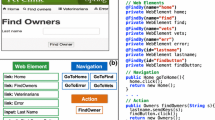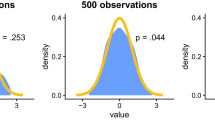Abstract
The work of Voas and colleagues has introduced, refined and applied the propagation, infection and execution (PIE) analysis technique for measuring testability of programs. The purpose of this paper is twofold: (1) to summarize and review the work done by Voas and others, and (2) to lay down a framework for automating the measurement of testability. In doing so, we introduce a prototype system, which uses the mutant schemata approach to calculate the infection estimate. The attempt, reported in this paper, to reproduce the results reported by Voas for one example, have shown that intermediate calculations are quite sensitive to minor variations in the parameters to the process, although the final testability results are in agreement.
Similar content being viewed by others
References
Al-Khanjari, Z.A. and Woodward, M.R. 1998. Investigations into the PIE testability technique, Proceedings of the 4th International Conference on Achieving Quality in Software (AQuIS '98), IEI-CNR, Venice, Italy, pp. 25-34.
Bache, R. and Müllerburg, M. 1990. Measures of testability as a basis for quality assurance, Software Engineering Journal, 5(2): 86-92.
Bainbridge, J. 1994. Defining testability metrics axiomatically, Software Testing, Verification and Reliability, 4(2): 63-80.
Bertolino, A. and Strigini, L. 1996. On the use of testability measures for dependability assessment, IEEE Transactions on Software Engineering, 22(2): 97-108.
Flanagan, S.J. 1997. Mutation testing using mutant schemata. B.Sc. Dissertation. The U.K., University of Liverpool.
Freedman, R.S. 1991. Testability of software components, IEEE Transactions on Software Engineering, 17(6): 553-564.
Friedman, M.A. and Voas, J.M. 1995. Software Assessment: Reliability, Safety, Testability, New York, John Wiley & Sons, Inc., New York.
Hamlet, R.G. 1987. Probable correctness theory, Information Processing Letters, 25(1): 17-25.
Morell, L.J. 1984. A theory of error-based testing, Ph.D. Thesis, Technical Report TR-1395. University of Maryland. Department of Computer Science.
Richardson, D.J. and Thompson, M.C. 1988. The RELAY model of error detection and its application. Proc. of the Second Workshop on Software Testing, Verification, and Analysis, Banff, Canada, IEEE Computer Society Press, pp. 223-230.
Untch, R.H. 1995. Schema-based mutation analysis: A new test data adequacy assessment method, Ph.D. Dissertation, Technical Report Clemson University, U.S.A., Department of Computer Science, pp. 95-115.
Untch, R.H., Offutt, A.J., and Harrold, M.J. 1993. Mutation analysis using mutant schemata. Proc. of the 1993 Int. Symposium on Software Testing and Analysis (ISSTA), ACM Press, Cambridge, Massachusetts, pp. 139-148.
Voas, J.M. 1992. PIE: A dynamic failure-based technique, IEEE Transactions on Software Engineering, 18(8): 717-727.
Voas, J.M. 1996. Object-oriented software testability, in Achieving Quality in Software, S. Bologna and G. Bucci (Eds.), London, U.K., Chapman & Hall. pp. 279-290.
Voas, J.M. and Miller, K.W. 1992. The revealing power of a test case, Software Testing, Verification and Reliability, 2(1): 25-42.
Voas, J.M. and Miller, K.W. 1993. Applying a dynamic testability technique to debugging certain classes of software faults, Software Quality Journal, 2(1): 61-75.
Voas, J.M. and Miller K.W. 1993. Semantic metrics for software testability, The Journal of Systems and Software, 20(3): 207-216.
Voas, J.M. and Miller, K.W. 1995. Software testability: the new verification, IEEE Software, 12(3): 17-28.
Voas, J.M., Morell, L.J., and Miller, K.W. 1991. Predicting where faults can hide from testing, IEEE Software, 8(2): 41-48.
Voas, J.M., Payne, J.E., and Miller, K.W. 1993. Designing programs that are less likely to hide faults, The Journal of Systems and Software, 20(1): 93-100.
Voas, J.M. and Miller, K.W. 1994. Dynamic testability analysis for assessing fault tolerance, High Integrity Systems Journal, 1(2): 171-178.
Author information
Authors and Affiliations
Rights and permissions
About this article
Cite this article
Al-Khanjari, Z., Woodward, M. & Ramadhan, H.A. Critical Analysis of the PIE Testability Technique. Software Quality Journal 10, 331–354 (2002). https://doi.org/10.1023/A:1022190021310
Issue Date:
DOI: https://doi.org/10.1023/A:1022190021310




